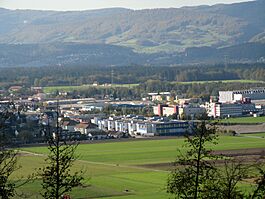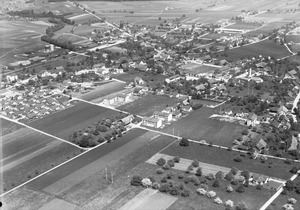Hunzenschwil facts for kids
Quick facts for kids
Hunzenschwil
|
||
|---|---|---|
 |
||
|
||
| Country | Switzerland | |
| Canton | Aargau | |
| District | Lenzburg | |
| Area | ||
| • Total | 3.26 km2 (1.26 sq mi) | |
| Elevation | 402 m (1,319 ft) | |
| Population
(Dec 2020 )
|
||
| • Total | 4,209 | |
| • Density | 1,291.1/km2 (3,344/sq mi) | |
| Postal code |
5502
|
|
| Surrounded by | Gränichen, Rupperswil, Schafisheim, Suhr | |
Hunzenschwil is a small town, also called a municipality, in Switzerland. It is located in the Lenzburg district within the canton of Aargau.
Contents
Hunzenschwil's Story
A Look Back in Time
Long ago, when the Romans were in Switzerland, the area where Hunzenschwil is today was a big brickyard. This means they made bricks there.
The name Hunzenschwil first appeared in old writings in 1101. Back then, it was called Hintziswil. Later, in 1201, it was known as Hunzeliswilre.
Who Ruled Hunzenschwil?
In the 1300s, the Habsburgs family had special rights over the village. These were called "high court rights." This meant they could make important decisions and judge serious crimes.
In 1415, these rights went to Bern, another important Swiss city. The "low court rights," which dealt with smaller local matters, were held by different owners. Eventually, in 1433, these rights also went to Bern.
By 1550, Hunzenschwil teamed up with three other towns: Niederlenz, Rupperswil, and Staufen. They formed their own independent local court.
Religion and Growth
For a long time, Hunzenschwil was part of the church community of Suhr. But in 1960, the town got its very own church.
Even though Hunzenschwil was on a main road between Bern and Zurich, it was mostly a farming village for many years. In the 1700s and 1800s, some textile businesses started up. They worked with linen, cotton, and silk ribbons.
In 1877, a train station was built, connecting Hunzenschwil to the Federal Railway network. This helped the town grow. After 1940, more modern industries arrived. Today, many jobs are in car-related businesses, furniture, or shipping. The town started growing much faster in 1950. A highway access road opened in 1965, making it easier to travel.
Where is Hunzenschwil?
Hunzenschwil covers an area of about 3.26 square kilometers (1.26 square miles). This is how the land is used:
- About 34% is used for farming.
- Around 24.5% is covered by forests.
- About 41% has buildings or roads.
- A tiny bit, 0.3%, is rivers or lakes.
Most of the built-up area includes industrial buildings, homes, and roads. The forests are mostly dense woods. The farming land is used for crops, pastures, and some fruit trees.
Hunzenschwil is in the Lenzburg district. It used to be a "linear village," meaning houses were built mostly along one main road. But since the 1940s, it has grown and spread out along other roads too.
Hunzenschwil's Coat of Arms
The town's official symbol, its coat of arms, shows a golden Greyhound dog jumping on a blue background.
People of Hunzenschwil
Population and Languages
Hunzenschwil has a population of about 4,207 people (as of 2020). About 23% of the people living here are from other countries.
Most people in Hunzenschwil speak German (about 86.3%). Italian is the second most common language (5.6%), followed by Albanian (2.6%).
Age Groups in Hunzenschwil
Here's a look at the different age groups in Hunzenschwil (as of 2008):
- Children (0-9 years old): 9.4%
- Teenagers (10-19 years old): 10.9%
- Young adults (20-29 years old): 15.2%
- Adults (30-39 years old): 15.2%
- Adults (40-49 years old): 16.6%
- Adults (50-59 years old): 13.8%
- Seniors (60-69 years old): 10.3%
- Seniors (70-79 years old): 5.2%
- Seniors (80-89 years old): 3.0%
- Seniors (90 and older): 0.5%
Homes and Households
In 2000, there were about 1,105 homes and apartments in Hunzenschwil. On average, there were 2.3 people living in each home. Many homes (about 55.6%) were owned by the people living in them, rather than rented.
In 2008, there were 501 single-family homes in the town. This was about 36.2% of all homes and apartments.
Political Choices
In the 2007 national election, the most popular political party in Hunzenschwil was the SVP. They received about 50.8% of the votes. Other popular parties included the SP (15.4%) and the FDP (10.4%).
Population Over Time
Here's how Hunzenschwil's population has changed through history:
| Historical population | ||
|---|---|---|
| Year | Pop. | ±% |
| 1764 | 301 | — |
| 1798 | 570 | +89.4% |
| 1837 | 810 | +42.1% |
| 1850 | 747 | −7.8% |
| 1900 | 670 | −10.3% |
| 1950 | 925 | +38.1% |
| 1980 | 2,219 | +139.9% |
| 2000 | 2,575 | +16.0% |
| 2010 | 3,201 | +24.3% |
| 2020 | 4,207 | +31.4% |
Important Historical Sites
One very important historical place in Hunzenschwil is called Ziegelmatte / Zotzelacker. This was the Roman brickyard we talked about earlier. It is listed as a special heritage site of national significance in Switzerland.
Hunzenschwil's Economy
Jobs and Businesses
In 2007, the unemployment rate in Hunzenschwil was 2.42%. This means only a small percentage of people looking for work couldn't find a job.
In 2005, there were different types of jobs:
- Primary sector: 58 people worked in farming or related businesses.
- Secondary sector: 482 people worked in manufacturing, like factories.
- Tertiary sector: 777 people worked in services, like shops, offices, or transportation.
Commuting to Work
In 2000, many people who lived in Hunzenschwil worked outside the town (about 77.3%). However, many people also came into Hunzenschwil for work.
Most people (57.2%) used a private car to get to work. About 9.7% used public transportation, like buses or trains.
Religious Life
Based on a 2000 survey, about 25.6% of the people in Hunzenschwil were Roman Catholic. A larger group, about 50.7%, belonged to the Swiss Reformed Church.
Learning and Education
Switzerland is known for its good education system. In Hunzenschwil, many adults (about 68.9%) have completed higher education, like college or a special technical school.
In the 2008/2009 school year, there were 186 students in primary school and 101 students in secondary school in Hunzenschwil.
The town also has its own library, called the Gemeindebibliothek Hunzenschwil. In 2008, it had 3,580 books and other items. It loaned out over 4,000 items that year.
See also
 In Spanish: Hunzenschwil para niños
In Spanish: Hunzenschwil para niños





